Block convoluiton using skew transform (overlap-save method)
Contents
Overlap-save
function []=overlapsaveqdft_demo()
% Classic overlapsave method is using FFT size of 2N, where N is block size. % Proposed method is using skew transform of size N for computation reduction. % Convolution mod(x^N-j) is used for each block, and the skew transform is an eigen transform of this skew convolution. % It is easy to see that multiplication of two polynomials y(z)=x(z)*h(z) (mod (x^N-j)), where x(z)=(x(0)+j*x(N))+(x(1)+j*x(N+1))*z+(x(2)+j*x(N+2))*z^2+..+(x(N-1)+j*x(2*N-1))*z^(N-1) is % combined of two adjacent blocks of input signal, % and h(z)=h(0)+h(1)*z+h(2)*z^2+..+h(N-1)*z^(N-1) is impulse response of a filter, will give convolution result for the block if output % is read as Y=[Re(y(0))... Re(y(N-1))].
Init
N=32; % block size x=randn(1,5*N); % input signal h=randn(1,N); % filter impulse response % y=fftfilt(h,x); % true result
Classic overlap-save method (FFT size = 2*N)
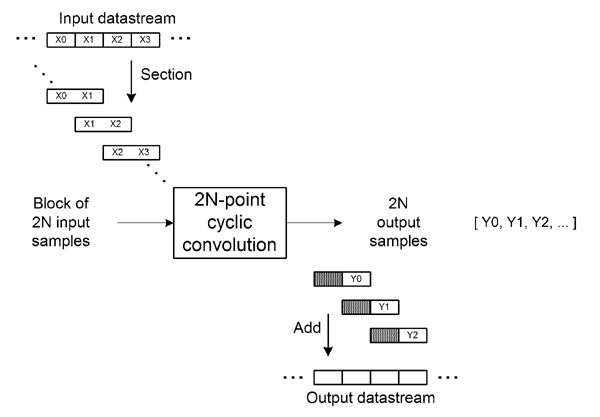
hs=fft(h',2*N); % filter spectral response xn=reshape(x,N,[]); xn=[zeros(N,1) xn(:,1:end-1); xn]; % xn=[xn; zeros(size(xn))]; xs=fft(xn); % block spectrum of input signal (FFT size = 2*N) ys=bsxfun(@times,hs,xs); % spectral domain multiplication y1=real(ifft(ys)); % block convolution result ycl=reshape(y1((1:N)+N,:),[],1); % block-wise graph figure(2) plot_blockwise_classic(y1,N,length(x)) subplot(size(y1,2)+1,1,size(y1,2)+1); plot(ycl) axis([0 round(length(x)+N*1.1) -20 20]); grid on ylabel(['output']);
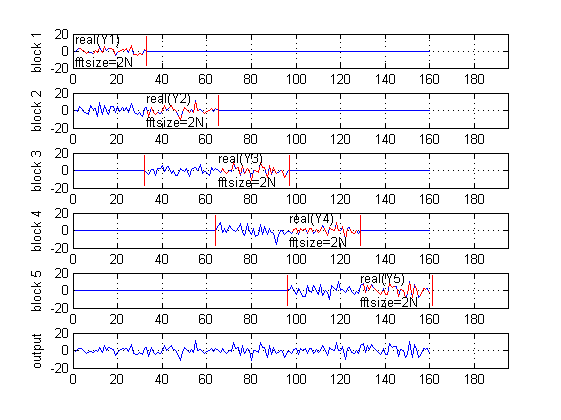
Proposed overlap-save method (FFT size = N)
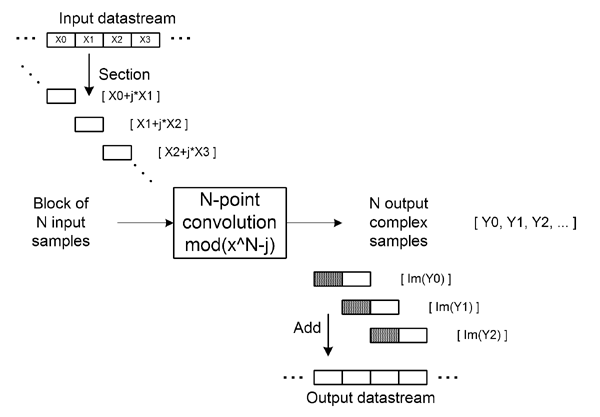
w=exp(1i*pi/2/N*(0:N-1)'); % diagonal elements for qDFT hs=fft(w.*h'); xn=reshape(x,N,[]); xn(:,2:end)=xn(:,1:end-1)+1i*xn(:,2:end); xn(:,1)=1i*xn(:,1); % combining input blocks x1=bsxfun(@times,w,xn); % pre-multiplication by diagonal twiddle factors s1=fft(x1); % block spectrum of input signal (qDFT size = N) s2=bsxfun(@times,hs,s1); % spectral domain multiplication y1=bsxfun(@times,conj(w),ifft(s2)); % block convolution result ypr=reshape(imag(y1),1,[]); % overlap-save combination % block-wise graph figure(1) % title('Proposed qDFT based method'); plot_blockwise_propose(y1,N,length(x)) % plot resulting output subplot(size(y1,2)+1,1,size(y1,2)+1); plot(ypr) axis([0 round(length(x)+N*1.1) -20 20]); grid on ylabel(['output']);
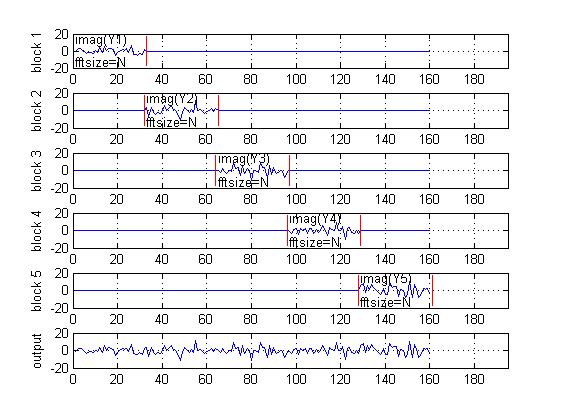
Compare results
figure(3) plot(ycl) hold on plot(ypr,'--r'); hold off grid on legend('classic','proposed')
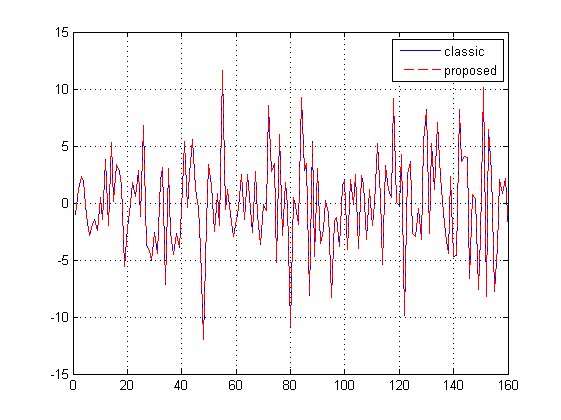
References
[1] Blahut, R.E.: Fast Algorithms for Signal Processing. Cambridge University Press (2010). (p. 198) [2] Jung Gap Kuk, Seyun Kim, and Nam Ik Cho, "A New Overlap Save Algorithm for Fast Block Convolution and Its Implementation Using FFT," Journal of Signal Processing Systems(Online), Feb 2010.
function []=plot_blockwise_classic(y1,N,lenx) for i=1:size(y1,2), y9=zeros(size(y1)); y9(:,i)=y1(:,i); yt=y9((1:N)+N,i); xt=(i-1)*N+(1:N); y9=reshape(y9((1:N)+N,:)+[y9(1:N,2:end) zeros(N,1)],1,[]); subplot(size(y1,2)+1,1,i); plot(y9) hold on plot(xt,yt,'--r'); a=17; plot([0 0]+(i-1-1)*N,[-a a],'r'); plot([1 1]+(i-1+1)*N,[-a a],'r'); text(1+(i-1)*N,-a*0.8,'fftsize=2N'); text(1+(i-1)*N,a*0.8,['real(Y' num2str(i) ')']); hold off axis([0 round(lenx+N*1.1) -20 20]); grid on ylabel(['block ' num2str(i)]); end function []=plot_blockwise_propose(y1,N,lenx) for i=1:size(y1,2), y9=zeros(size(y1)); y9(:,i)=y1(:,i); y9=reshape(imag(y9),1,[]); subplot(size(y1,2)+1,1,i); plot(y9) hold on a=17; plot([0 0]+(i-1)*N,[-a a],'r'); plot([1 1]+(i-1+1)*N,[-a a],'r'); % plot([0 0]+(i-1+2)*N,[-a a],'r'); text(1+(i-1)*N,-a*0.8,'fftsize=N'); text(1+(i-1)*N,a*0.8,['imag(Y' num2str(i) ')']); % text(1+(i-1+1)*N,a*0.8,['imag(Y' num2str(i) ')']); hold off axis([0 round(lenx+N*1.1) -20 20]); grid on ylabel(['block ' num2str(i)]); end